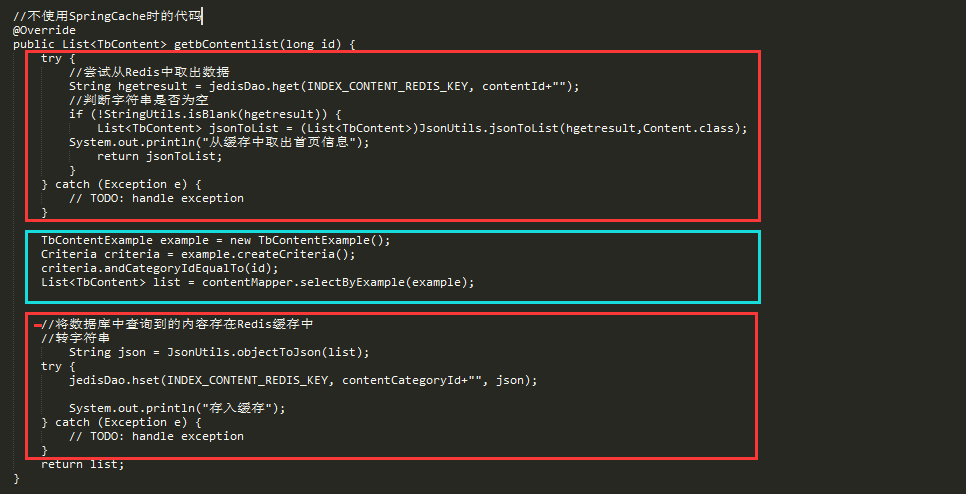缓存可以说是加速服务响应速度的一种非常有效并且简单的方式。在缓存领域,有很多知名的框架,如ehcache 、guava、hazelcast等。redis作为key-value型数据库,由于他的这一特性,redis也成为一种流行的数据缓存工具。
在传统方式下对于缓存的处理代码是非常臃肿的。
例如:我们要把一个查询函数加入缓存功能,大致需要三步。
一、在函数执行前,我们需要先检查缓存中是否存在数据,如果存在则返回缓存数据
二、如果不存在,就需要在数据库的数据查询出来。
三、最后把数据存放在缓存中,当下次调用此函数时,就可以直接使用缓存数据,减轻了数据库压力。
那么实现上面的三步需要多少代码呢?下面是一个示例:

上图中的红色部分都是模板代码,真正与这个函数有关的代码却只占了1/5,对于所有需要实现缓存功能的函数,都需要加上臃肿的模板代码。可谓是一种极不优雅的解决方案。
那么如何让臃肿的代码重回清新的当初呢?
aop不就是专门解决这种模板式代码的最佳方案吗,幸运的是我们不需要再自己实现切面了,springcache已经为我们提供好了切面,我们只需要进行简单的配置,就可以重回当初了,像下面这样:

只需要加一个注解就可以了,对于原来的代码连改都不需要改,是不是已经跃跃欲试了?
对于配置springcache只需要三步:
第一步:加入相关依赖:
|
1
2
3
4
5
6
7
8
9
10
11
12
13
14
15
|
<dependency> <groupid>redis.clients</groupid> <artifactid>jedis</artifactid> <version>2.9.0</version> </dependency> <dependency> <groupid>org.springframework.data</groupid> <artifactid>spring-data-redis</artifactid> <version>1.6.0.release</version> </dependency> <dependency> <groupid>org.apache.commons</groupid> <artifactid>commons-lang3</artifactid> <version>3.3.2</version></dependency> |
第二步:配置springcache,redis连接等信息
applicationcontext-redis.xml
|
1
2
3
4
5
6
7
8
9
10
11
12
13
14
15
16
17
18
19
20
21
22
23
24
25
26
27
28
29
30
31
32
33
34
35
36
37
38
39
40
41
42
43
44
45
|
<?xml version="1.0" encoding="utf-8"?><beans xmlns="http://www.springframework.org/schema/beans" xmlns:xsi="http://www.w3.org/2001/xmlschema-instance" xmlns:p="http://www.springframework.org/schema/p" xmlns:context="http://www.springframework.org/schema/context" xmlns:mvc="http://www.springframework.org/schema/mvc" xmlns:cache="http://www.springframework.org/schema/cache" xsi:schemalocation="http://www.springframework.org/schema/beans http://www.springframework.org/schema/beans/spring-beans-4.2.xsd http://www.springframework.org/schema/context http://www.springframework.org/schema/context/spring-context-4.2.xsd http://www.springframework.org/schema/mvc http://www.springframework.org/schema/mvc/spring-mvc-4.2.xsd http://www.springframework.org/schema/cache http://www.springframework.org/schema/cache/spring-cache-4.2.xsd"> <!-- 配置文件加载 --> <context:property-placeholder location="classpath:*.properties"/><cache:annotation-driven cache-manager="cachemanager"/> <!-- redis连接池 --> <bean id="poolconfig" class="redis.clients.jedis.jedispoolconfig"> <property name="maxidle" value="${redis.maxidle}" /> <property name="maxwaitmillis" value="${redis.maxwait}" /> <property name="testonborrow" value="${redis.testonborrow}" /> </bean> <!-- 连接工厂 --> <bean id="jedisconnectionfactory" class="org.springframework.data.redis.connection.jedis.jedisconnectionfactory" p:host-name="${redis.host}" p:port="${redis.port}" p:password="${redis.pass}" p:pool-config-ref="poolconfig"/> <!-- redis模板 --> <bean id="redistemplate" class="org.springframework.data.redis.core.redistemplate"> <property name="connectionfactory" ref="jedisconnectionfactory" /> </bean> <bean id="cachemanager" class="org.springframework.cache.support.simplecachemanager"> <property name="caches"> <set> <!-- 这里可以配置多个redis --> <bean class="com.cky.rest.utils.rediscache"> <property name="redistemplate" ref="redistemplate" /> <property name="name" value="content"/> <!-- name对应的名称要在类或方法的注解中使用 --> </bean> </set> </property> </bean> </beans> |
redis.properties文件:
|
1
2
3
4
5
6
7
8
9
10
11
12
13
14
15
|
# redis settings # server ip redis.host=192.168.100.55# server port redis.port=6379# server pass redis.pass=# use dbindex redis.database=0#max idel instance of jedisredis.maxidle=300#if wait too long ,throw jedisconnectionexceptionredis.maxwait=3000#if true,it will validate before borrow jedis instance,what you get instance is all usefullredis.testonborrow=true |
第三步,编写cache接口实现类
spring对于缓存只是提供了抽象的接口,并且通过接口来调用功能,没有具体的实现类,所以需要我们自己实现具体的操作。
在上面配置中可知,每个实现类都会注入一个redistemplate实例,我们就可以通过redistemplate来操作redis
|
1
2
3
4
5
6
7
8
9
10
11
12
13
14
15
16
17
18
19
20
21
22
23
24
25
26
27
28
29
30
31
32
33
34
35
36
37
38
39
40
41
42
43
44
45
46
47
48
49
50
51
52
53
54
55
56
57
58
59
60
61
62
63
64
65
66
67
68
69
70
71
72
73
74
75
76
77
78
79
80
81
82
83
84
85
86
87
88
89
90
91
92
93
94
95
96
97
98
99
100
101
102
103
104
105
106
107
108
109
110
111
112
113
114
115
116
117
118
119
|
package com.cky.rest.utils;import java.io.serializable;import org.apache.commons.lang3.serializationutils;import org.springframework.cache.cache;import org.springframework.cache.support.simplevaluewrapper;import org.springframework.dao.dataaccessexception;import org.springframework.data.redis.connection.redisconnection;import org.springframework.data.redis.core.rediscallback;import org.springframework.data.redis.core.redistemplate;public class rediscache implements cache { private redistemplate<string, object> redistemplate; private string name; @override public void clear() { system.out.println("-------緩存清理------"); redistemplate.execute(new rediscallback<string>() { @override public string doinredis(redisconnection connection) throws dataaccessexception { connection.flushdb(); return "ok"; } }); } @override public void evict(object key) { system.out.println("-------緩存刪除------"); final string keyf=key.tostring(); redistemplate.execute(new rediscallback<long>() { @override public long doinredis(redisconnection connection) throws dataaccessexception { return connection.del(keyf.getbytes()); } }); } @override public valuewrapper get(object key) { system.out.println("------缓存获取-------"+key.tostring()); final string keyf = key.tostring(); object object = null; object = redistemplate.execute(new rediscallback<object>() { @override public object doinredis(redisconnection connection) throws dataaccessexception { byte[] key = keyf.getbytes(); byte[] value = connection.get(key); if (value == null) { system.out.println("------缓存不存在-------"); return null; } return serializationutils.deserialize(value); } }); valuewrapper obj=(object != null ? new simplevaluewrapper(object) : null); system.out.println("------获取到内容-------"+obj); return obj; } @override public void put(object key, object value) { system.out.println("-------加入缓存------"); system.out.println("key----:"+key); system.out.println("key----:"+value); final string keystring = key.tostring(); final object valuef = value; final long livetime = 86400; redistemplate.execute(new rediscallback<long>() { @override public long doinredis(redisconnection connection) throws dataaccessexception { byte[] keyb = keystring.getbytes(); byte[] valueb = serializationutils.serialize((serializable) valuef); connection.set(keyb, valueb); if (livetime > 0) { connection.expire(keyb, livetime); } return 1l; } }); } @override public <t> t get(object arg0, class<t> arg1) { // todo auto-generated method stub return null; } @override public string getname() { return this.name; } @override public object getnativecache() { return this.redistemplate; } @override public valuewrapper putifabsent(object arg0, object arg1) { // todo auto-generated method stub return null; } public redistemplate<string, object> getredistemplate() { return redistemplate; } public void setredistemplate(redistemplate<string, object> redistemplate) { this.redistemplate = redistemplate; } public void setname(string name) { this.name = name; }} |
在配置过程中曾经出现过两次错误:
1.xxxx.classnotfoundexception 最后发现是jar下载不完整,把maven本地仓库的对应jar包文件夹删除完从新下载就好了
2.xxxx.methodnotfoundexception 这种情况是版本不对,换成第一步中的版本就可以了
springcache中常见注解的使用:
@cacheable注解
最常用的注解,会把被注解方法的返回值缓存。工作原理是:首先在缓存中查找,如果没有执行方法并缓存结果,然后返回数据。此注解的缓存名必须指定,和cachemanager中的caches中的某一个cache的name值相对应。可以使用value或cachenames指定。
如果没有指定key属性,spring会使用默认的主键生成器产生主键。也可以自定义主键,在key中可以使用spel表达式。如下:
|
1
2
3
4
|
@cacheable(cachenames=”content”,key=”#user.userid”)public user getuser(user user){ xxxxx} |
可以使用condition属性,来给缓存添加条件,如下:
|
1
2
|
@cacheable(cachenames=”content”,key=”#user.userid”,condition=”#user.age<40”)public user getuser(user user){xxxxx} |
@cacheput注解
先执行方法,然后将返回值放回缓存。可以用作缓存的更新。
@cacheevict注解
该注解负责从缓存中显式移除数据,通常缓存数据都有有效期,当过期时数据也会被移除。
此注解多了两个属性:
allentries是否移除所有缓存条目。
beforeinvocation:在方法调用前还是调用后完成移除操作。true/false
以上就是本文的全部内容,希望对大家的学习有所帮助,也希望大家多多支持服务器之家。
原文链接:http://www.cnblogs.com/chenkeyu/p/8028781.html















